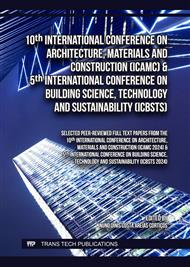[1]
A. Miano et al., "The use of satellite data to support the structural health monitoring in areas affected by slow-moving landslides: a potential application to reinforced concrete buildings," https://doi.org/10.1177/1475921720983232, vol. 20, no. 6, p.3265–3287, Jan. 2021.
DOI: 10.1177/1475921720983232
Google Scholar
[2]
D. Tonelli, A. Valentini, A. Rocca, S. Zorzi, A. Lotti, and D. Zonta, "Uncertainty quantification of satellite InSAR-monitoring of bridges: a case study," ce/papers, vol. 6, no. 5, p.900–906, Sep. 2023.
DOI: 10.1002/CEPA.1991
Google Scholar
[3]
D. Tonelli et al., "Interpretation of Bridge Health Monitoring Data from Satellite InSAR Technology," Remote Sensing 2023, Vol. 15, Page 5242, vol. 15, no. 21, p.5242, Nov. 2023.
DOI: 10.3390/RS15215242
Google Scholar
[4]
F. C. Ponzo, G. Auletta, P. Ielpo, and R. Ditommaso, "DInSAR–SBAS satellite monitoring of infrastructures: how temperature affects the 'Ponte della Musica' case study," J Civ Struct Health Monit, vol. 14, no. 3, p.745–761, Jan. 2024.
DOI: 10.1007/s13349-023-00751-z
Google Scholar
[5]
P. F. Giordano, Z. I. Turksezer, M. Previtali, and M. P. Limongelli, "Damage detection on a historic iron bridge using satellite DInSAR data," https://doi.org/10.1177/14759217211054350, vol. 21, no. 5, p.2291–2311, Mar. 2022.
DOI: 10.1177/14759217211054350
Google Scholar
[6]
A. Miano, F. Di Carlo, A. Mele, M. Bonano, A. Prota, and A. Meda, "Damage Assessment Through the Use of SBAS-DInsar Data: An Application to the 'Vittorino da Feltre' Masonry School Building in Rome," International Journal of Architectural Heritage, May 2023.
DOI: 10.1080/15583058.2023.2213188
Google Scholar
[7]
G. Delo, M. Civera, E. Lenticchia, G. Miraglia, C. Surace, and R. Ceravolo, "Interferometric Satellite Data in Structural Health Monitoring: An Application to the Effects of the Construction of a Subway Line in the Urban Area of Rome," Applied Sciences 2022, Vol. 12, Page 1658, vol. 12, no. 3, p.1658, Feb. 2022.
DOI: 10.3390/APP12031658
Google Scholar
[8]
A. Mele et al., "On the Joint Exploitation of Satellite DInSAR Measurements and DBSCAN-Based Techniques for Preliminary Identification and Ranking of Critical Constructions in a Built Environment," Remote Sensing 2022, Vol. 14, Page 1872, vol. 14, no. 8, p.1872, Apr. 2022.
DOI: 10.3390/RS14081872
Google Scholar
[9]
A. Mele, M. Crosetto, A. Miano, and A. Prota, "ADAfinder Tool Applied to EGMS Data for the Structural Health Monitoring of Urban Settlements," Remote Sensing 2023, Vol. 15, Page 324, vol. 15, no. 2, p.324, Jan. 2023.
DOI: 10.3390/RS15020324
Google Scholar
[10]
D. A. Talledo et al., "Satellite radar interferometry: Potential and limitations for structural assessment and monitoring," Journal of Building Engineering, vol. 46, p.103756, Apr. 2022.
DOI: 10.1016/J.JOBE.2021.103756
Google Scholar
[11]
C. C. Aggarwal, Data mining: the textbook. Springer New York, 2015.
Google Scholar
[12]
V. Mugnaini, L. Zanotti Fragonara, and M. Civera, "A Machine Learning Approach for Automatic Operational Modal Analysis.," Mech Syst Signal Process, vol. 170, 2022.
DOI: 10.1016/j.ymssp.2022.108813
Google Scholar
[13]
M. Civera, V. Mugnaini, and L. Zanotti Fragonara, "Machine Learning-Based Automatic Operational Modal Analysis: A Structural Health Monitoring Application to Masonry Arch Bridges," Struct Control Health Monit, vol. 29, no. 10, p. e3028, Jun. 2022.
DOI: 10.1002/stc.3028
Google Scholar


